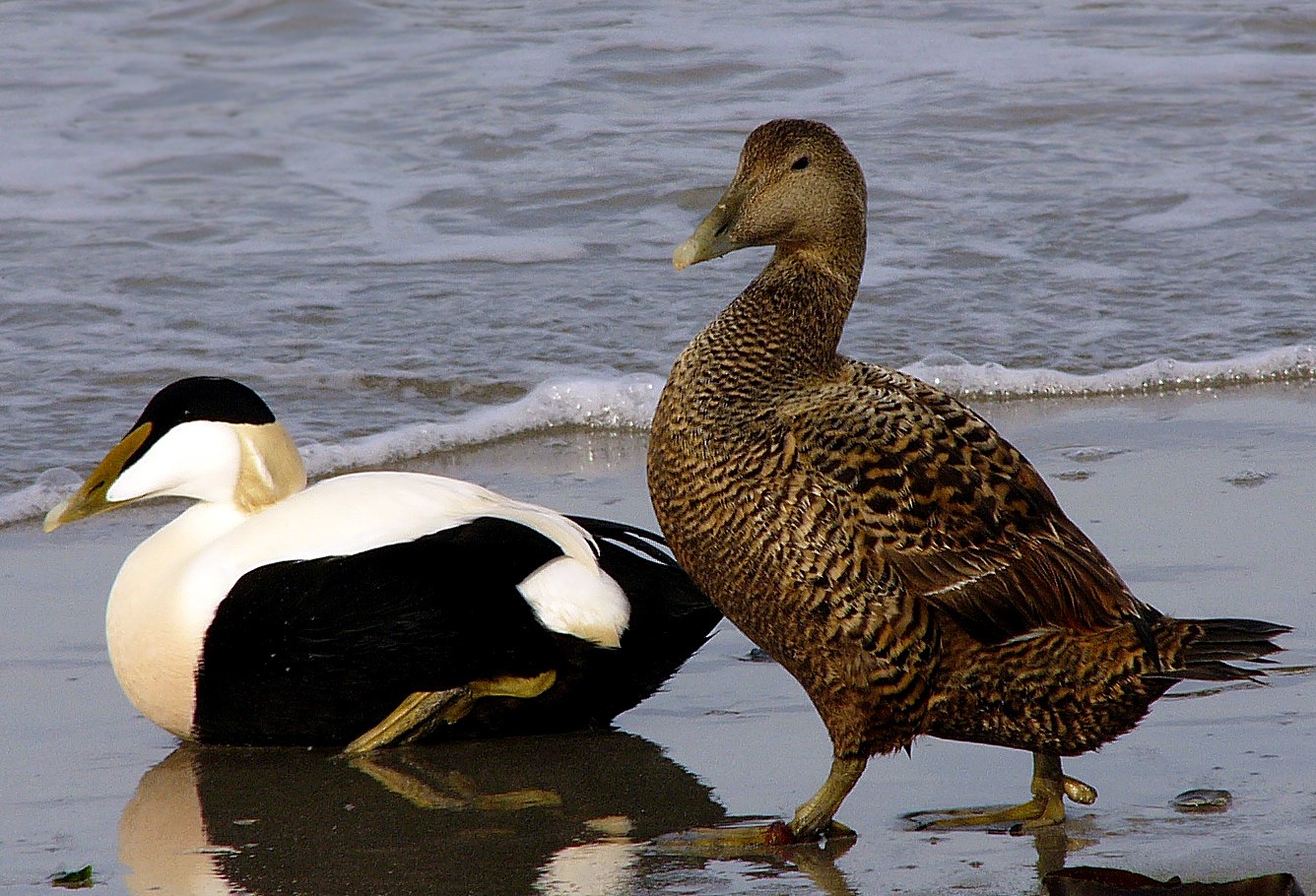Common Eider
A species of Typical Eiders, Also known as American Eider, Eider Duck Scientific name : Somateria mollissima Genus : Typical Eiders
Common Eider, A species of Typical Eiders
Also known as:
American Eider, Eider Duck
Botanical name: Somateria mollissima
Genus: Typical Eiders
Content
Description People often ask General Info
 Photo By Andreas Trepte , used under CC-BY-SA-2.5 /Cropped and compressed from original
Photo By Andreas Trepte , used under CC-BY-SA-2.5 /Cropped and compressed from original Description
The common eider is both the largest of the four eider species and the largest duck found in Europe, and is exceeded in North America only by smatterings of the Muscovy duck, which only reaches North America in a wild state in southernmost Texas and south Florida. It measures 50 to 71 cm (20 to 28 in) in length, weighs 0.81 to 3.04 kg (1.8 to 6.7 lb) and spans 80–110 cm (31–43 in) across the wings. The average weight of 22 males in the North Atlantic was 2.21 kg (4.9 lb) while 32 females weighed an average of 1.92 kg (4.2 lb). It is characterized by its bulky shape and large, wedge-shaped bill. The male is unmistakable, with its black and white plumage and green nape. The female is a brown bird, but can still be readily distinguished from all ducks, except other eider species, on the basis of size and head shape. The drake's display call is a strange almost human-like "ah-ooo," while the hen utters hoarse quacks. The species is often readily approachable. Drakes of the European, eastern North American and Asia/western North American races can be distinguished by minor differences in plumage and bill colour. Some authorities place the subspecies v-nigra as a separate species. This species dives for crustaceans and molluscs, with mussels being a favoured food. The eider will eat mussels by swallowing them whole; the shells are then crushed in their gizzard and excreted. When eating a crab, the eider will remove all of its claws and legs, and then eat the body in a similar fashion. It is abundant, with populations of about 1.5–2 million birds in both North America and Europe, and also large but unknown numbers in eastern Siberia (HBW). A particularly famous colony of eiders lives on the Farne Islands in Northumberland, England. These birds were the subject of one of the first ever bird protection laws, established by Saint Cuthbert in the year 676. About 1,000 pairs still nest there every year. Because St. Cuthbert is the patron saint of Northumberland, it was natural that the eider should be chosen as the county's emblem bird; the birds are still often called Cuddy's ducks in the area, "Cuddy" being the familiar form of "Cuthbert". In Canada's Hudson Bay, important eider die-offs were observed in the 1990s by local populations due to quickly changing ice flow patterns. The Canadian Wildlife Service has spent several years gathering up-to-date information on their populations, and preliminary results seem to show a population recovery. The common eider is the object of the 2011 documentary People of a Feather, which studies the historical relationship between the Sanikiluaq community and eiders, as well as various aspects of their ecology. The common eider is one of the species to which the Agreement on the Conservation of African-Eurasian Migratory Waterbirds (AEWA) applies. 
Size
58 - 69 cm
Colors
Black
White
Life Expectancy
18 years
Nest Placement
Ground
Clutch Size
3 - 8 eggs
Incubation Period
1 brood
Number of Broods
24 - 26 days
Feeding Habits
Common Eider predominantly consume mollusks, crustaceans, echinoderms, marine worms, and fish eggs, favoring blue mussels and green sea urchins. They feed more during low tides, prying food from rocks and bringing urchins to the surface to eat. Ducklings also ingest marine algae, gastropods, and amphipods.
Habitat
Common Eider primarily resides in marine settings, nesting on coastal terrains interspersed with vegetation within the Arctic tundra or stunted taiga. Their habitat features rocky coasts and nearby shallow waters. Juveniles congregate in protected saltwater zones after hatching. Migratory paths include freshwater lakes, with winter habitats comprising dynamic, food-rich tidal rocky seabeds, and ice-flecked open waters.
Nest Behavior
Common Eider females reuse nesting sites and begin lining with down post the third egg. The down conceals eggs during absences. Nesting occurs annually, with precise egg-laying and incubation patterns followed by parental care of the hatchlings.
Nest Characteristics
Common Eider nests are typically located close to the sea, often utilizing previous years' sites. They favor areas with some cover like rocks or vegetation. These ground nests have a depression lined with the female's down after the third egg, measuring approximately 10 inches in diameter.
Dite type
Aquatic invertebrate eater
People often ask
General Info
Feeding Habits
Bird food type
Behavior
Common Eider demonstrate a blend of monogamous traits and mate displays beyond their pair bonds, sometimes reuniting with previous partners in subsequent seasons. Their courtship begins in autumn's tranquility, involving elaborate antics like head tossing and soft cooing, extending to off-season mating in fall and winter. While common Eider females, known for their distinct down-lined nests, usually nest in colonies (or solitarily in some regions), they don't hesitate to repurpose other waterfowl or gull nests. The males support the incubation process by staying nearby, later retreating to molt and indulge in feeding sprees. Notably, common Eider showcase reduced aggression compared to other ducks, favoring head-lowering and chin-lifting gestures during confrontations, with occasional disputes arising in densely nested areas.
Species Status
Not globally threatened.